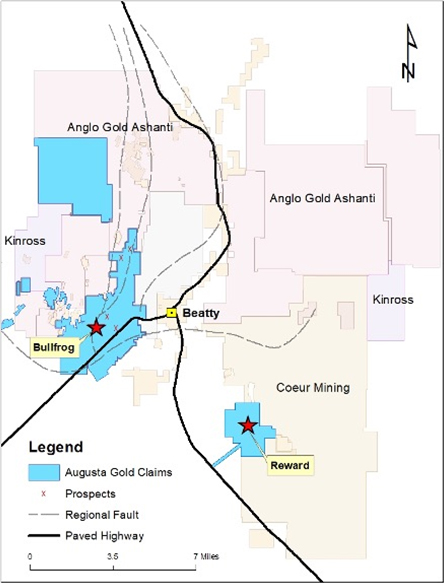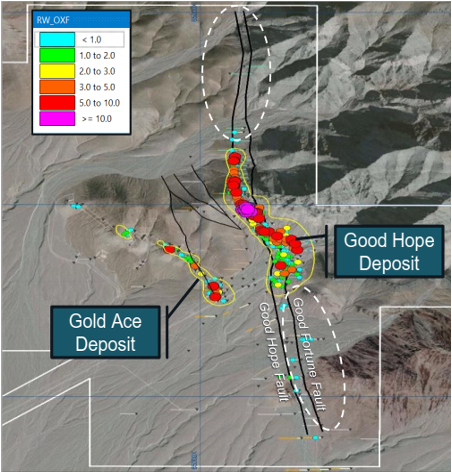I agree to and consent to receive news, updates, and other communications by way of commercial electronic messages (including email) from Augusta Gold Corp. I understand I may withdraw consent at any time by clicking the unsubscribe link contained in all emails from Augusta Gold Corp.
Overview
The Reward Project is located in the prolific Walker Lane Trend approximately 120 miles north-west of Las Vegas, Nevada and 7 miles East of the Bullfrog Gold Project. Reward is a fully permitted, low-risk heap leach project located in a top mining jurisdiction.
Figure 1:
Exploration
Exploration potential within the prolific Walker Lane Trend, the zones north and south of the Good Hope deposit are mineralized and remain largely untested. Potential to expand Reward’s resource profile from discovery in untested zones.
Within the Good Hope deposit, recent drilling intersected significant mineralization along the Good Fortune Fault. Mineralization is observed in multiple stratigraphic units and interpreted to be both structural and stratigraphically controlled.
Good Hope and Gold Ace Deposits
Geology & Mineralization
Mineralization in the Good Hope Deposit and Golden Ace Zone can be classified as examples of a structurally controlled, locally disseminated, sediment hosted, mesothermal quartz vein gold deposit.
The Project is hosted within the Bare Mountain Complex which lies within an intricate tectonic setting of the Nevada Basin and Range Province.
The Bare Mountain Complex consist of up to 6,096 m (20,000 ft) of Upper Proterozoic to Paleozoic marine sedimentary rocks in the lower plate that have been juxtaposed against Miocene silicic volcanic sequences in the upper plate. The lower plate units were deformed through folding, thrust faulting, low and high angle normal faulting during a Mesozoic compression event, and have been metamorphosed from lower amphibolite to sub-greenschist grade. Two dominant normal fault sets have been mapped in the lower plate, including the moderately east-dipping Bare Mountain and Gold Ace faults, and shallowly southeast-dipping faults that cut or curve into east-dipping faults.
The Project is located on the southwestern flank of the Bare Mountain Complex and is underlain by moderately-deformed marine clastic and carbonate rocks of Late Proterozoic and Late Cambrian age that have been metamorphosed to greenschist grade. Tertiary and younger alluvium cover the lower slopes and the adjacent Armagosa Valley to the south and west. The east-dipping Gold Ace fault, locally termed the Good Hope fault zone, separates northeast dipping Late Proterozoic to Early Cambrian units in the footwall block from Middle to Late Cambrian units in the hanging wall block.
The gold mineralization in the Good Hope Deposit is spatially associated with, and along, the Good Hope fault zone, and is primarily hosted in altered and veined Wood Canyon Formation, and to a lesser extent, in the Juhl and Sutton Members of the Stirling Formation. Mineralization hosted along the contact between the Sutton and Morris Marble Members of the Stirling Formation is referred to as the Gold Ace Zone. Although there are small historic prospects along the Good Hope fault zone, most of the historic production came from the Gold Ace Zone.



